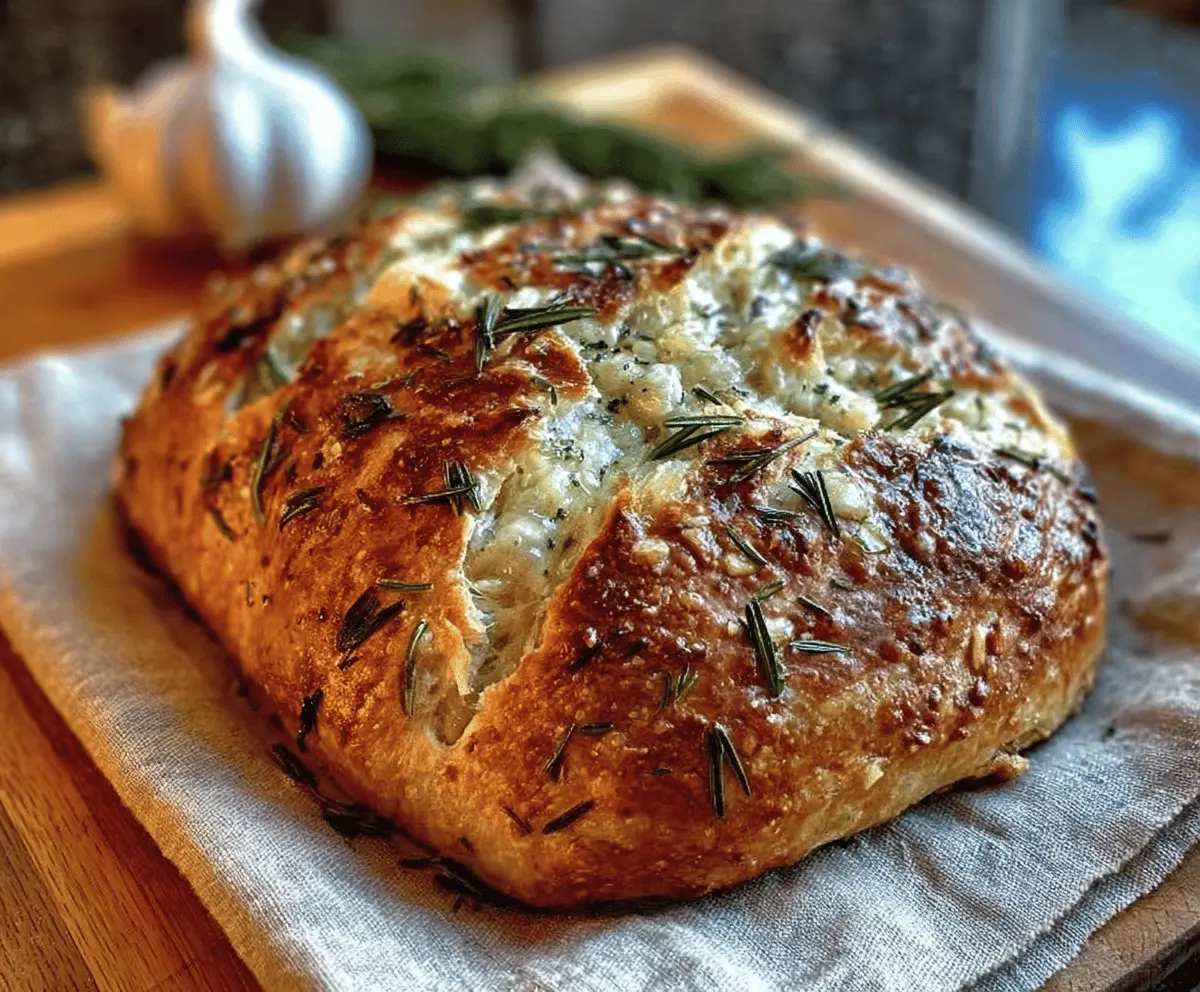Rustic No-Knead Rosemary Garlic Bread is a simple yet flavorful loaf that’s perfect for sharing any time of day. It has a crisp crust with a soft, chewy inside, boosted by fresh rosemary and the rich, warm taste of garlic. This bread looks like it belongs in a cozy kitchen, fresh out of the oven, with its golden color and lovely herb scent filling the air.
I love making this because it’s so easy — no kneading means less effort but the flavor and texture don’t suffer at all. The rosemary and garlic bring such a lovely aroma that makes the whole house feel welcoming. I usually mix the ingredients in a bowl, let the dough rest, and by the next day, it’s ready to bake. It feels like magic how something so simple can taste so good.
My favorite way to enjoy this bread is warm, with butter melting right on top or alongside a bowl of soup to soak up the flavors. It’s a great side for dinners or just a snack to share with friends. Every time I make it, people ask for the recipe because it’s just that good. If you want a fresh, delicious bread without much fuss, this is the one I’d recommend trying first.
Key Ingredients & Substitutions
All-purpose flour: This is the base of the bread. You can swap half with whole wheat flour for a nuttier taste, but the loaf may be denser. Using bread flour adds more chewiness because of its higher protein.
Fresh rosemary: It gives a wonderful aroma and flavor. If you don’t have fresh, dried rosemary works too—use about one-third the amount, as dried herbs are stronger.
Garlic: Fresh minced garlic infuses the bread with warmth and depth. For a milder taste, try roasted garlic or garlic powder. Infusing olive oil with garlic before brushing the dough boosts flavor nicely.
Instant yeast: It’s perfect for no-knead recipes because it activates quickly. If you only have active dry yeast, dissolve it in warm water first and let it sit for 5-10 minutes before mixing.
How Can You Make No-Knead Bread Turn Out Perfectly Every Time?
No-knead bread relies on time for gluten development instead of hands-on kneading. Here’s how to get it right:
- Long rise: Letting the dough rest 12-18 hours develops flavor and texture. Make sure your kitchen is around room temperature and avoid drafts.
- Handling dough gently: When shaping, use floured hands and fold the dough carefully without pressing out air bubbles. This keeps the bread light.
- Preheated Dutch oven: Baking in a hot covered pot traps steam, creating a crunchy crust and soft inside. Don’t forget to preheat it for about 30 minutes.
- Scoring: Cutting the dough’s top allows it to expand without cracking unevenly. Use a sharp knife and make confident, deep cuts.
- Cooling: Let the bread cool on a wire rack for at least an hour. This helps the crumb finish setting and keeps the crust crisp.
Equipment You’ll Need
- Dutch oven with lid – It traps steam for a crispy crust and keeps the bread moist inside.
- Large mixing bowl – Perfect for stirring the dough without making a mess.
- Wooden spoon or spatula – Makes mixing the sticky dough easier without scratching your bowl.
- Kitchen towels – Use them to cover the dough and let it rise without drying out.
- Baking sheet or cooling rack – To cool the bread so the crust stays crunchy.
Flavor Variations & Add-Ins
- Add grated parmesan cheese to the dough for a nutty, salty twist that pairs well with rosemary.
- Mix in chopped sun-dried tomatoes for a sweet, tangy contrast to the garlic and herbs.
- Try swapping rosemary for thyme or oregano to change the herb flavor while keeping it fresh.
- Include a handful of chopped olives for a briny punch that works great as a snack or with meals.

Rustic No-Knead Rosemary Garlic Bread
Ingredients You’ll Need:
Main Ingredients:
- 3 cups all-purpose flour
- 1 ½ teaspoons salt
- 1 teaspoon instant yeast
- 1 ½ cups warm water (about 110°F / 43°C)
- 2 tablespoons fresh rosemary needles, chopped (plus extra for topping)
- 3 garlic cloves, minced
- 1 tablespoon olive oil (for garlic infusion and brushing)
- Extra flour for dusting
Time Needed:
This recipe requires 15 minutes for mixing and assembling, plus a long 12 to 18 hours for the first rise. After shaping, you’ll let it rest about 1 to 2 hours before baking. The baking itself takes roughly 45 minutes. Expect to spend most of the time waiting while the dough rises, making it a great hands-off recipe.
Step-by-Step Instructions:
1. Infuse Garlic in Olive Oil
Start by mixing the minced garlic with the olive oil in a small bowl. Set this aside to let the garlic flavor infuse into the oil while you make the dough.
2. Mix the Dough
In a large mixing bowl, whisk together the flour, salt, and instant yeast. Add the warm water and the chopped rosemary. Stir everything with a wooden spoon or spatula just until it forms a sticky, shaggy dough — no kneading needed!
3. First Rise
Cover the bowl with plastic wrap or a clean kitchen towel and leave it at room temperature for 12 to 18 hours. The dough should double in size and develop bubbles, signaling it’s ready.
4. Shape the Dough
Generously flour a clean surface and gently turn the risen dough onto it. With floured hands, fold the dough over itself 2 to 3 times to create a rough ball.
5. Second Rise
Lightly grease a clean kitchen towel and place the dough seam-side down on it. Dust the top lightly with flour, cover with another towel, and let it rest about 1 to 2 hours, until it has nearly doubled again.
6. Prepare to Bake
Thirty minutes before baking, place a Dutch oven or heavy pot with a lid into your oven and preheat to 450°F (230°C). This preheating creates steam essential for a crusty loaf.
7. Bake the Bread
Carefully remove the hot pot from the oven. Lightly dust the bottom with flour or cornmeal to prevent sticking. Transfer the dough into the pot, seam-side up. Score a deep cross on top using a sharp knife to help the dough expand. Brush the top with the garlic-infused olive oil and sprinkle extra rosemary over it.
8. Final Baking
Cover the pot and bake for 30 minutes. Then remove the lid and bake for another 15 minutes or until golden brown and crusty.
9. Cool and Serve
Take the bread out of the pot and place it on a wire rack to cool for at least one hour before slicing. This resting time lets the bread’s texture set perfectly.
Enjoy your delicious Rustic No-Knead Rosemary Garlic Bread warm, maybe with a dab of butter or alongside your favorite soup!
Can I Use Dried Rosemary Instead of Fresh?
Yes! Use about one-third the amount of dried rosemary since it’s more concentrated. Add it when mixing the dough just like fresh rosemary for great flavor.
Can I Make This Bread Without a Dutch Oven?
Absolutely! Use a heavy baking sheet and place a pan of hot water in the oven to create steam, which helps achieve a crispy crust. Just be sure to preheat the oven well.
How Should I Store Leftover Bread?
Store it in a paper bag or loosely wrapped in a kitchen towel at room temperature for up to 2 days to keep the crust crisp. For longer storage, freeze sliced bread in an airtight bag and toast slices as needed.
Can I Add Other Flavors or Ingredients?
Yes! Try adding grated Parmesan, olives, sun-dried tomatoes, or swapping rosemary for thyme or oregano to customize the bread to your taste.

